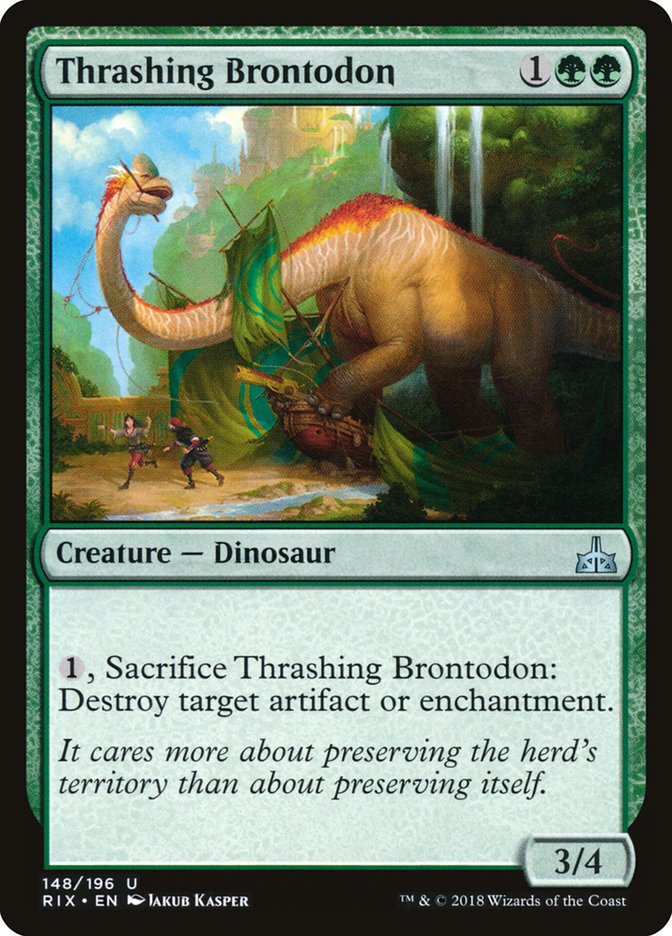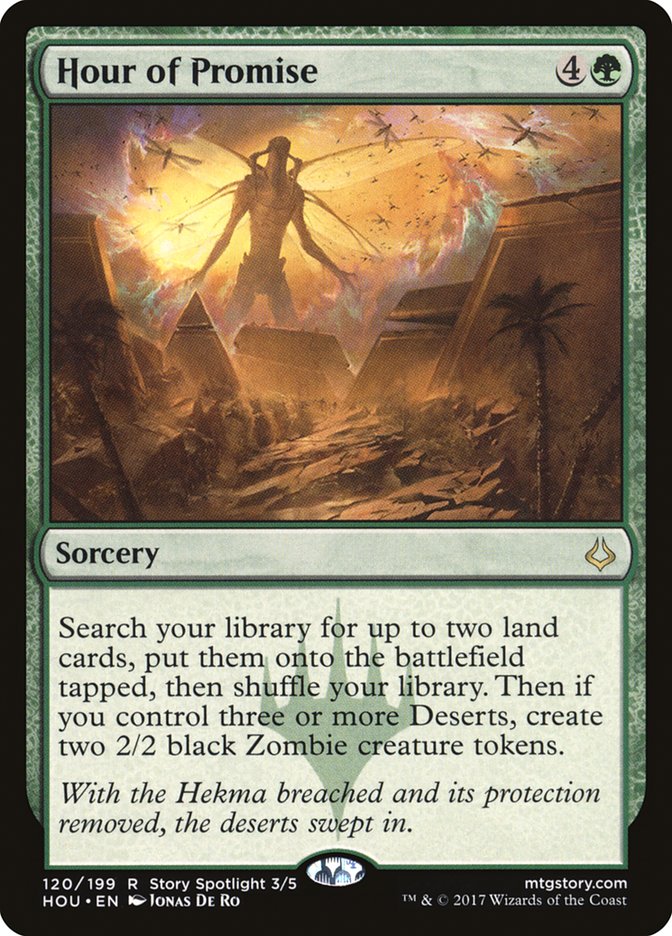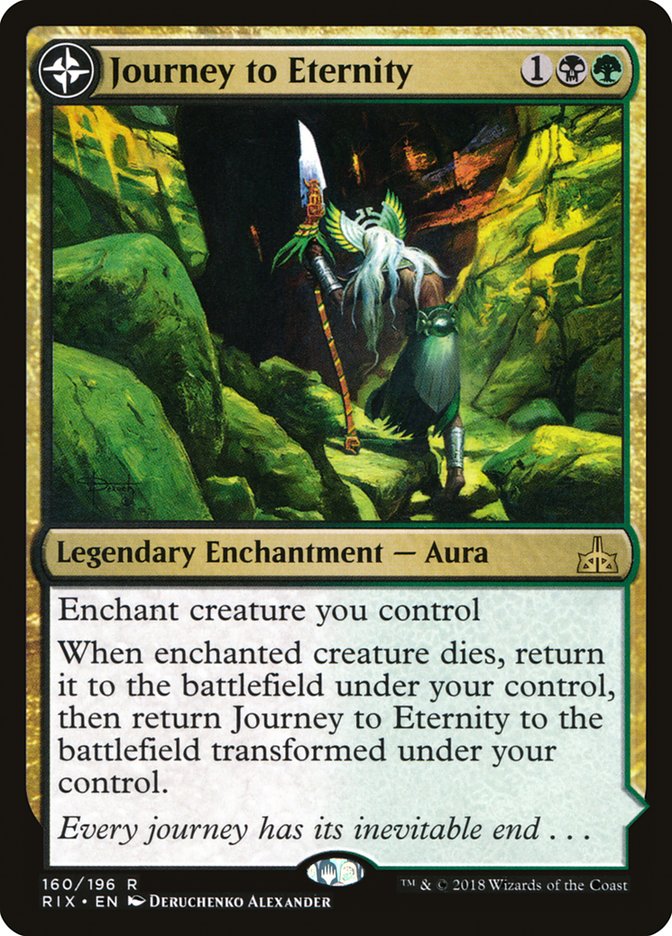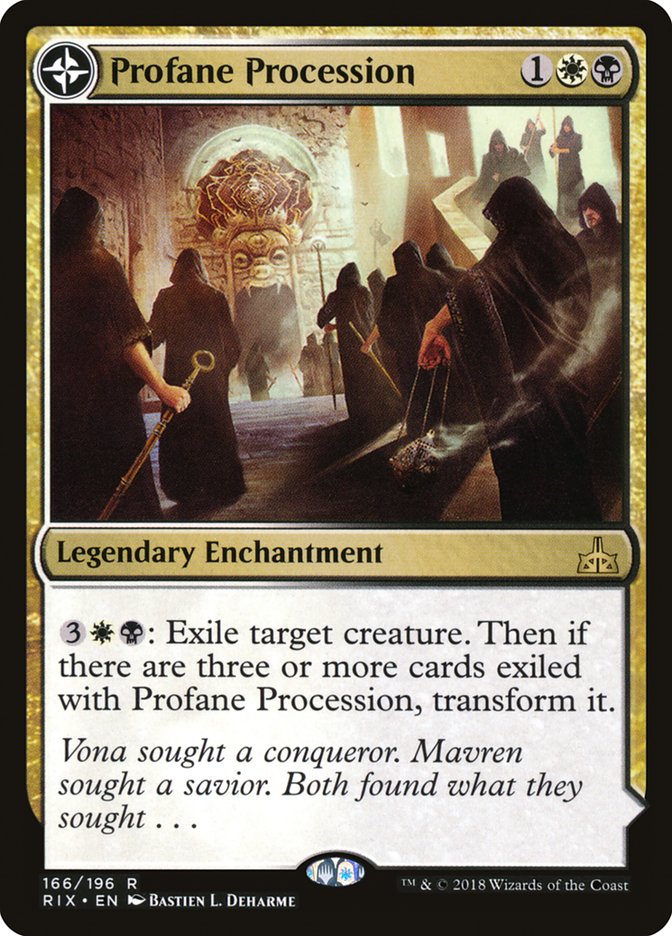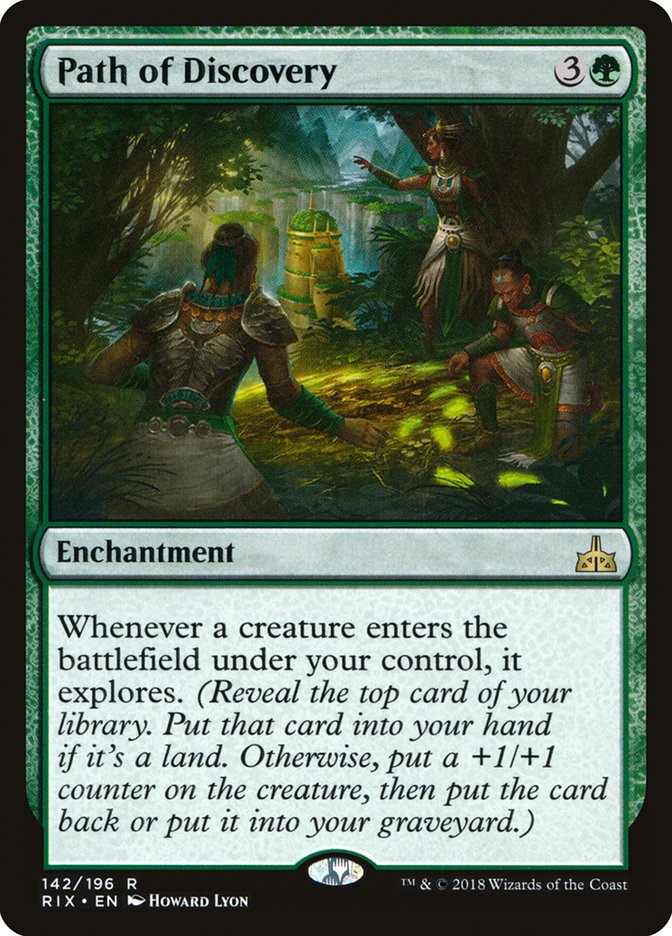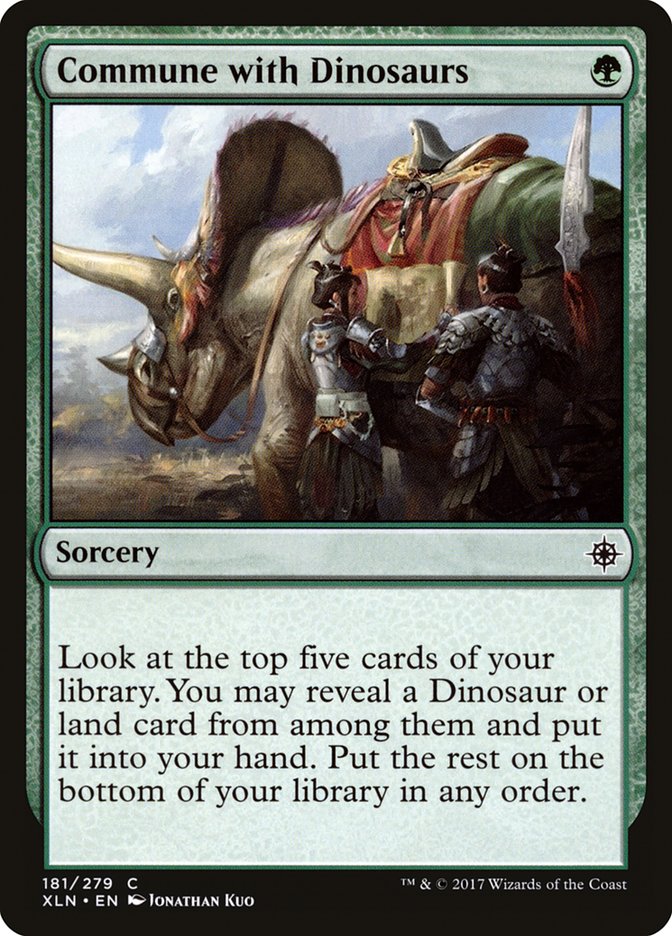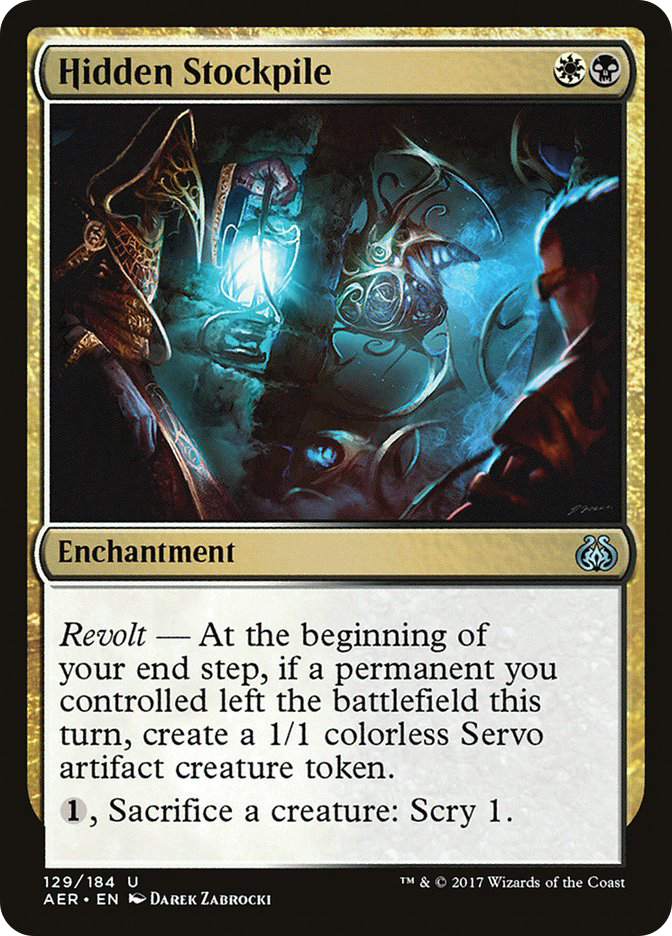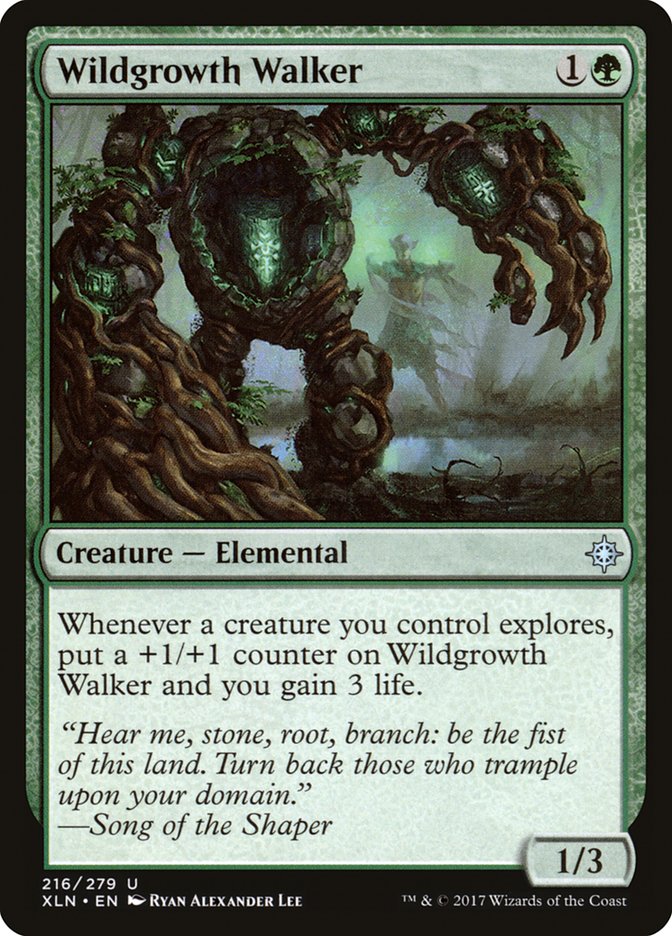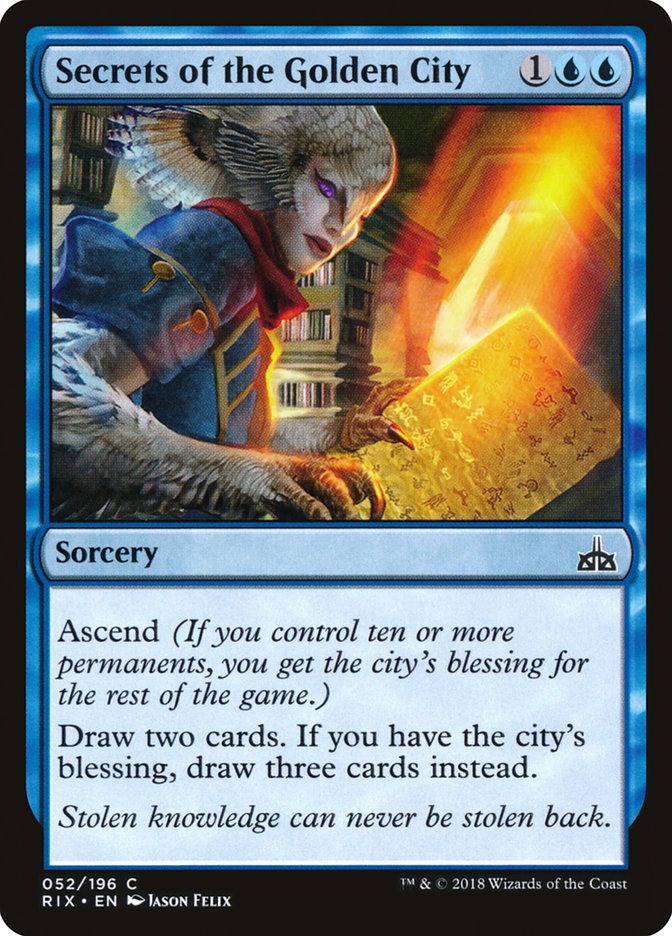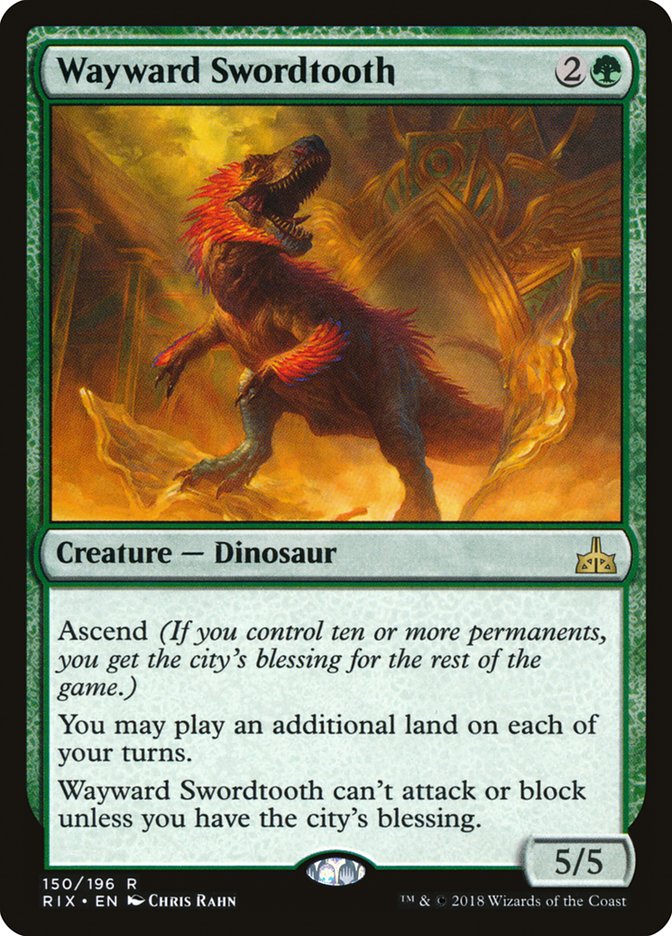I’ve been experimenting with a variety of different takes on B/G/x decks in Standard, and I like a lot of what’s going on, but I haven’t figured out the best way to build it, so I wanted to talk through a lot of the engines and packages I’m looking at.
I love black in the current Standard primarily due to the strength of Fatal Push and Vraska’s Contempt. Moment of Craving and Golden Demise help round things out in the sideboard, and access to Duress lets you get away with playing a bunch of removal in your maindeck because you can sideboard it out for a fantastic card against control. I feel like all of these one-for-one cards play really well with the wide variety of powerful transform cards and planeswalkers available in Standard. There are many ways to grind, and I like the defensive shell that lets you get down to the business of finding the best way to grind.
Out of green, I’m really into Thrashing Brontodon. Its body is big enough that it’s never an embarrassment, and the ability covers a lot of bases. Many of the powerful things you can do to go long in this format are artifacts or enchantments, so Thrashing Brontodon makes it easy to beat other people who are trying to do similar things, but not so well-prepared. It also complements Vraska’s Contempt nicely.
Hour of Promise is also fantastic right now. If you have a Desert, four other lands, and any other permanent, it gets you the city’s blessing, which doesn’t matter for a lot of good cards in Standard. It does, however, matter for Arch of Orazca, which, as it so happens, Hour of Promise can find while also helping you get enough mana to use it, so that’s a really simple package to have a decent ability to grind in long games. Its utility goes well beyond that, however; in addition to utility Deserts like Ifnir Deadlands and Scavenger Grounds, it can also find Field of Ruin, another way to break up opposing bids for inevitability with various transform cards.
Speaking of transform cards, I still love them, and I’m starting to come around on Journey to Eternity in Standard. Thrashing Brontodon and Walking Ballista are solid creatures on their own, and that gives you a core of up to eight creatures that can sacrifice themselves if you can resolve a Journey to Eternity on them (if you need to, the Thrashing Brontodon can attempt to destroy the Journey to Eternity and it’ll all work out fine for you; you’ll have a Thrashing Brontodon and a Cave of Eternity when all is said and done). It’s definitely better if you can find more than eight easy ways to transform the Journey to Eternity, but I’m not sure playing one is bad with just that.
My preferred other options are Hidden Stockpile (of course), Banewhip Punisher (great to be able to return with Cave of Eternity), and theoretically Atzocan Seer, but getting the Dinosaur in the graveyard is a little tricky.
Journey to Eternity isn’t the only transform card I’m interested in. Profane Procession is really powerful, and I’m even optimistic about Golden Guardian, especially if you can play good creatures to fight with it (especially Wayward Swordtooth…remember what I was saying about Hour of Promise and the city’s blessing?). As with planeswalkers, you don’t need to play very many transform cards for them to have a serious impact on your plans, since transforming any of them can have such a large impact on a game.
Another card that I’ve liked more than I expected is Path of Discovery. It certainly feels like it should be terrible, but I think about it kind of like Anointed Procession: either one is fantastic with Hidden Stockpile. If you have Path of Discovery, instead of getting two 1/1s, you get a 1/1 and an explore, which is different but comparable. It doesn’t scale as well, which is to say that the second Anointed Procession is amazing, while the second Path of Discovery is a little lackluster, but that means you can just play fewer of them. More importantly, Path of Discovery works with any other creature you happen to want to put in your deck, and while Anointed Procession works with any token you might want to play, those are generally at least a little harder to come by.
As an added bonus, Path of Discovery plays really well with Journey to Eternity, since exploring allows you to put creatures directly into your graveyard, and returning them from your graveyard explores again (in case you’re wondering, yes, my interest in this was inspired by a game of Limited).
So there are a lot of cards I’m interested in for this kind of deck, more than I can reasonably play in a single deck, so how do I choose which ones I want to use?
I’ve written a long time ago about how I think of deckbuilding in clusters, which is a particularly useful framework for this kind of deck, so let’s talk through some clusters and how they do and don’t fit together.
Dinosaurs
Commune with Dinosaurs is a fantastic card, and getting to play this kind of effect will make a deck a lot better (think about how strong Ancient Stirrings is in Modern). The trick is finding enough Dinosaurs you want to put in your deck, and ideally, you’ll want Dinosaurs with a variety of costs and effects.
Thrashing Brontodon is a highlight here, as are great finishers like Tetzimoc, Primal Death and Carnage Tyrant. Another potentially strong reward for playing Dinosaurs is Thunderherd Migration. For a midrange deck in these colors, there’s a good chance that if you’re playing either Commune with Dinosaurs or Thunderherd Migration, you’ll likely want to play the other.
There aren’t enough good Dinosaurs to reliably cast Thunderherd Migration for two mana without playing Commune with Dinosaurs to set it up, and if you’re playing enough for Thunderherd Migration, I can’t imagine that you wouldn’t also want Commune with Dinosaurs anyway. It’s possible that you’d want Commune with Dinosaurs and not Thunderherd Migration, but I think that if you have enough Dinosaurs, you’re probably going to be interested in the ramp spell and a little short on things to do for two mana.
So if you’re trying to play those, what are the Dinosaurs you’re looking at?
Thrashing Brontodon is the best start. Then I could see probably three total Tetzimoc, Primal Death and Carnage Tyrant; maybe a Zetalpa, Primal Dawn (though I’m skeptical of that one); and then you’ll need some more midrange Dinosaurs to round it out. Your best options are Wayward Swordtooth, Ranging Raptors, and Ripjaw Raptor. If you go for the enrage Dinosaurs, you’ll probably want to play Savage Stomp (this is a bit of a combo with Journey to Eternity), and if you’re playing Wayward Swordtooth, you’ll want a lot of lands, explore, card draw, or other great ways to get the city’s blessing, like Hour of Promise. (Note the clusters within clusters here!) I think you can probably get away with something like ten to twelve Dinosaurs, maybe even fewer if you’re satisfied with paying three mana for Thunderherd Migration sometimes, which honestly isn’t that bad.
Creatures (16)
- 4 Walking Ballista
- 1 Carnage Tyrant
- 2 Ripjaw Raptor
- 4 Ranging Raptors
- 4 Thrashing Brontodon
- 1 Tetzimoc, Primal Death
Planeswalkers (1)
Lands (24)
Spells (19)

This uses the enrage Dinosaurs, and while I’m a little low on Savage Stomp because I don’t want to overload on removal and I think the black instant-speed removal is more important, it’s nice that the enrage Dinosaurs also happen to play really well with Walking Ballista.
Hidden Stockpile
Hidden Stockpile requires white mana, obviously, and it also plays best if you have Renegade Map and Evolving Wilds in your deck. If you play Hidden Stockpile, it gives you the option to play Anointed Procession or Path of Discovery, though neither is required. It also substantially increases your ability to use Journey to Eternity reliably.
At the moment, I think the Hidden Stockpile manabase is somewhat at odds with Hour of Promise and somewhat at odds with Commune with Dinosaurs. You don’t really want both Commune with Dinosaurs and Renegade Map as one-mana plays (though you might be able to play something like four Commune with Dinosaurs and two Renegade Map), and it’s very hard to have good enough mana for a three-color deck while playing enough basics for Renegade Map and Evolving Wilds and enough Deserts for Hour of Promise, since none of those are multicolor lands.
Evolving Wilds and Renegade Map are both great for making mana work, but it gets really tricky even if it looks like you theoretically have enough sources of each because you have to choose a single color for each of them to find, and curving Hidden Stockpile into Thrashing Brontodon or Commune with Dinosaurs (if you want to play it) into Hidden Stockpile is pretty tricky. Jadelight Ranger is another great card we’d like to be able to use that also has a casting cost that doesn’t play well with Hidden Stockpile in a deck with relatively few actual multicolor lands.
If you play Path of Discovery, it opens the door to consider trying to play enough explore for Wildgrowth Walker, which gets out of hand really quickly with Hidden Stockpile and Path of Discovery, but you don’t want to rely entirely on Path of Discovery to make it work. Fortunately, Wildgrowth Walker into Jadelight Ranger is a powerful enough curve that your opponent will have to respect Wildgrowth Walker, and sometimes you’ll just have that great start even if you just play Jadelight Ranger, Wildgrowth Walker, and Path of Discovery, but I’d still feel a lot better about it if we could play Merfolk Branchwalker as well.
The problem is Hidden Stockpile, Wildgrowth Walker, and Merfolk Branchwalker are already a lot of two-mana spells; not too many, but it’s hard to play those with Walking Ballista, which is too bad, because Walking Ballista plays well with Journey of Discovery (it benefits more than average from an extra +1/+1 counter and it plays well when we’re always hitting all of our land drops thanks to exploring).
The other tricky part is that I have a hard time pulling the trigger on playing four Path of Discovery rather than maybe two, and I don’t think Wildgrowth Walker is worth it unless you’re willing to really commit. The result so far has been that whenever I actually try to make a list, I’ve moved away from going deep on explore, but any time I have Hidden Stockpile and Path of Discovery on the battlefield, I really wish my deck had Wildgrowth Walker.
Incidentally, another concern if you’re really pushing explore is that I think it doesn’t like having cards like Renegade Map in your deck, since they decrease the number of lands you run and I’m pretty sure you’re generally hoping to put a land in your hand when you explore, but I think this tension is pretty minor (you still get the consolation +1/+1 counter, after all).
If I’m playing Hidden Stockpile, I’d like to play Journey to Eternity and Profane Procession. Profane Procession is mostly just a function of having white mana in my deck and planning to play a long game. Journey to Eternity I want because of the additional sacrifice outlet.
Once I’m playing Hidden Stockpile and Journey to Eternity, I start looking to prioritize enters-the-battlefield abilities, so I’m looking for things like Jadelight Ranger and Ravenous Chupacabra.
Creatures (15)
- 4 Walking Ballista
- 1 Banewhip Punisher
- 4 Thrashing Brontodon
- 1 Tetzimoc, Primal Death
- 3 Jadelight Ranger
- 2 Ravenous Chupacabra
Planeswalkers (2)
Lands (23)
Spells (20)

This is a sample of how I’ve been building the deck without really pushing the explore synergies.
Hour of Promise
Hour of Promise requires a lot of Deserts, clearly, which has interesting implications for what the rest of your deck can support in terms of mana requirements. On the one hand, it’s great fixing, but on the other, your lands are so restricted that it can be hard to make things work. It offers the city’s blessing, which means that it plays well with Wayward Swordtooth. Wayward Swordtooth, for its part, plays well with Ramunap Excavator, which in turn plays well with Deserts (and especially Evolving Wilds, which doesn’t play especially well with Deserts, so there’s a little tension there).
If you can somehow make the mana work, I think Hour of Promise plays extremely well with Secrets of the Golden City, which seems like a powerful enough card to warrant consideration in Constructed if you can reliably attain the city’s blessing. Still, so far, finding a manabase that can realistically support UU while doing everything else I want has eluded me.
You’re not required to play Wayward Swordtooth to play Hour of Promise, but it is nice that it can help you cast Hour of Promise on Turn 4 (as long as you’ve drawn five lands by the fourth turn), and as a Dinosaur it potentially lets you play the Dinosaur package (though you have to watch your basic land count with Thunderherd Migration, but Thunderherd Migration and Commune with Dinosaurs do a lot to improve your mana), and Thunderherd Migration gives you another way to cast Hour of Promise on Turn 4.
If you play Wayward Swordtooth, I really like playing at least one Golden Guardian as well, since Wayward Swordtooth makes it so easy to flip.
Hour of Promise also invites playing some kind of powerful endgame to use all this mana on. I’m not sure that there’s a better option than The Scarab God or Profane Procession, and any transform cards you put in your deck will benefit considerably from having extra mana around.
Creatures (15)
Planeswalkers (1)
Lands (24)
Spells (20)

This deck’s mana is a bit of a stretch, with only fourteen green sources despite playing 24 land with four Commune with Dinosaurs and three Thunderherd Migration. I actually wonder if the correct way to build this kind of deck is to play even more lands to maximize Wayward Swordtooth, but I’m not sure what to cut at this point and it still feels like a lot of mana.
I haven’t played enough with these decks to figure out precisely how competitive they are, but they’re definitely doing something sweet, and I see plausible reasons to believe they’d be competitive with other decks in Standard.


